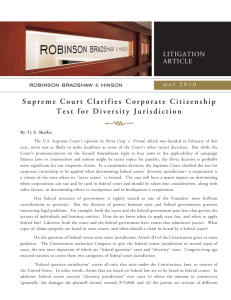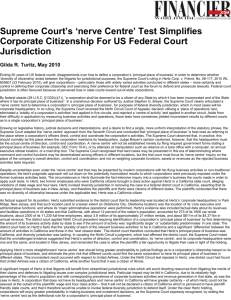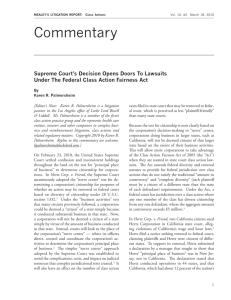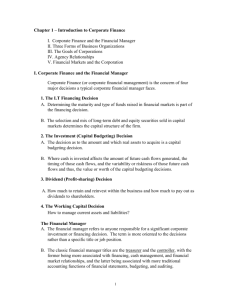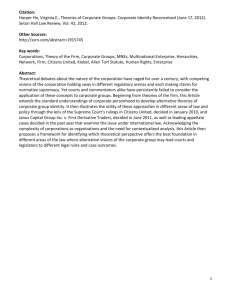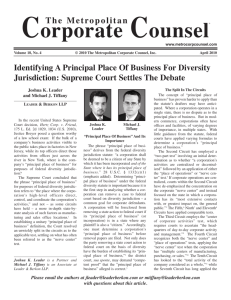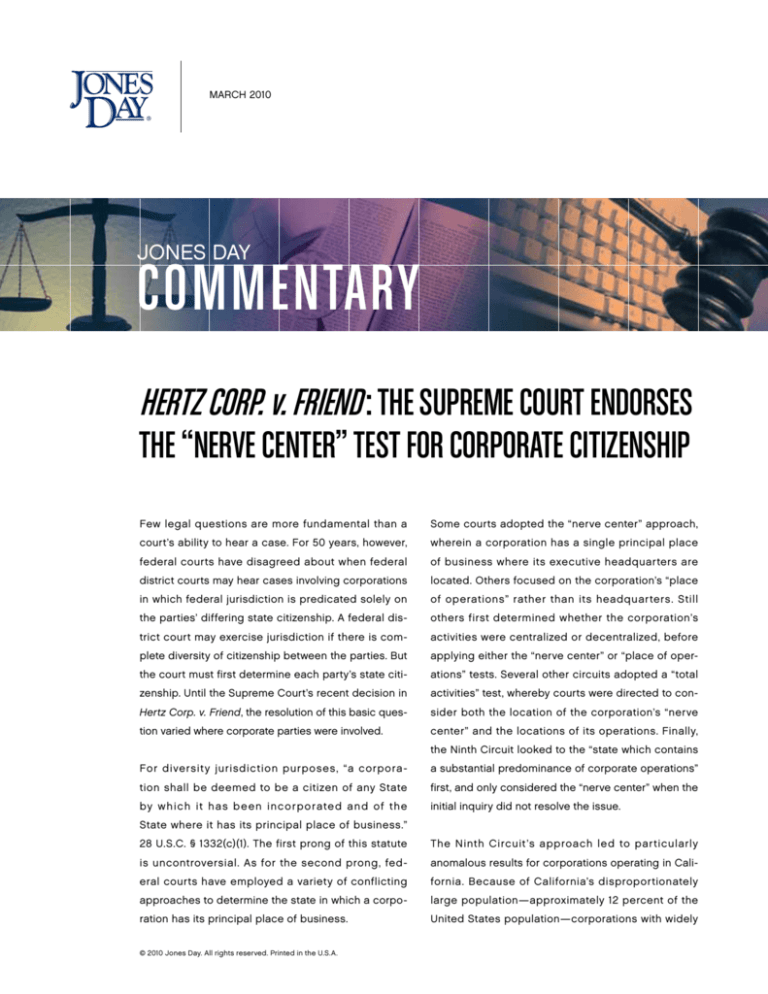
March 2010
JONES DAY
COMMENTARY
Hertz Corp. v. Friend : The Supreme Court Endorses
the “Nerve Center” Test for Corporate Citizenship
Few legal questions are more fundamental than a
Some courts adopted the “nerve center” approach,
court’s ability to hear a case. For 50 years, however,
wherein a corporation has a single principal place
federal courts have disagreed about when federal
of business where its executive headquarters are
district courts may hear cases involving corporations
located. Others focused on the corporation’s “place
in which federal jurisdiction is predicated solely on
of operations” rather than its headquarters. Still
the parties’ differing state citizenship. A federal dis-
others first determined whether the corporation’s
trict court may exercise jurisdiction if there is com-
activities were centralized or decentralized, before
plete diversity of citizenship between the parties. But
applying either the “nerve center” or “place of oper-
the court must first determine each party’s state citi-
ations” tests. Several other circuits adopted a “total
zenship. Until the Supreme Court’s recent decision in
activities” test, whereby courts were directed to con-
Hertz Corp. v. Friend, the resolution of this basic ques-
sider both the location of the corporation’s “nerve
tion varied where corporate parties were involved.
center” and the locations of its operations. Finally,
the Ninth Circuit looked to the “state which contains
For diversit y jurisdiction purposes, “a corpora-
a substantial predominance of corporate operations”
tion shall be deemed to be a citizen of any State
first, and only considered the “nerve center” when the
by which it has b e en incorp orate d and of the
initial inquiry did not resolve the issue.
State where it has its principal place of business.”
28 U.S.C. § 1332(c)(1). The first prong of this statute
The Ninth Circuit ’s approach led to particularly
is uncontroversial. As for the second prong, fed-
anomalous results for corporations operating in Cali-
eral courts have employed a variety of conflicting
fornia. Because of California’s disproportionately
approaches to determine the state in which a corpo-
large population—approximately 12 percent of the
ration has its principal place of business.
United States population—corporations with widely
© 2010 Jones Day. All rights reserved. Printed in the U.S.A.
dispersed operations were at times found to be California
The Court also affirmed that the burden of persuasion
corporations, despite the fact that they were headquartered
remains on the party asserting diversity jurisdiction and
in other states and conducted the overwhelming majority of
emphasized that the “nerve center” approach does not
their business outside of California.
permit jurisdictional manipulation. A party challenged in its
assertion of jurisdiction must support its allegations by com-
The complexity and unpredictability of the Ninth Circuit’s
petent proof. For example, the Court noted that the mere fil-
approach became plain in recent years. In October 2008,
ing of a form like the Securities and Exchange Commission’s
the Ninth Circuit affirmed a district court’s decision that
Form 10-K listing a corporation’s “principal executive offices”
Hertz Corp., which argued it was headquartered in New Jer-
would not, on its own, establish the corporation’s “nerve cen-
sey, was a California corporation because 17 percent of its
ter.” Nonetheless, even if the record shows manipulation,
facilities, 18.6 percent of its revenues, and 21.5 percent of its
courts do not revert to the corporation’s “place of opera-
employees were located in California. But in February 2009,
tions.” Rather, the court must identify the place of actual
the Ninth Circuit reversed a district court’s decision con-
direction, control, and coordination of the corporation, in the
cluding that Best Buy Co., Inc., which argued it was head-
absence of such manipulation.
quartered in Minnesota, was a California corporation merely
because 11 percent of its retail stores, 13 percent of its rev-
Hertz has a variety of implications for corporations. First, all
enues, and 13 percent of its employees were located in
federal courts will be required to apply the same test when
California. In June 2009, the Supreme Court granted Hertz’s
locating the state in which the corporation has its princi-
petition for a writ of certiorari.
pal place of business. Anomalous results between courts
should be virtually eliminated, and corporations should no
In its subsequent decision in Hertz Corp. v. Friend (No.
longer be considered citizens of more than one state under
08-1107), the Supreme Court unanimously endorsed the
the “principal place of business” prong of the federal diver-
“nerve center” approach for determining the state in which
sity jurisdiction statute.
a corporation has its principal place of business. The Court
concluded “that the phrase ‘principal place of business’
Second, many corporations that were previously considered
refers to the place where the corporation’s high level officers
citizens of more populous states in which the “nerve cen-
direct, control, and coordinate the corporation’s activities,”
ter” test was not employed, particularly California, will now
adding that “the ‘nerve center’ will typically be found at a
have the opportunity to remove state court actions to fed-
corporation’s headquarters.”
eral courts in those states. For instance, corporations that
long have been considered California citizens on the basis
Although the Court’s decision addressed the statute’s text
of their operations will have a new opportunity to reevaluate
and legislative history, the Court placed particular empha-
their California citizenship for diversity jurisdiction purposes.
sis on the administrative simplicity of the “nerve center” approach. It noted that complex jurisdictional rules
Third, some corporations may find that they are unable
“encourage gamesmanship” and waste judicial resources.
to remove state-court cases in states in which they previ-
Simple jurisdictional rules, however, promote greater pre-
ously were able to do so. For instance, a corporation with
dictability for “corporations making business and invest-
its headquarters in California and the bulk of its operations
ment decisions” and for “plaintiffs deciding whether to
in Arizona may have been able to remove a case from Cali-
file suit in a state or federal court.” Although the Court
fornia state court to federal court under the previous Ninth
acknowledged that the “nerve center” test will not always
Circuit approach, but it would no longer be able to exercise
be precise, it is comparatively simpler than tests focusing
that option.
on a corporation’s operations.
2
Finally, a corporation must be prepared to support its jurisdictional allegations with proof of the place from which it
actually is directed, controlled, and coordinated. Although
the body of case law applying the “nerve center” approach
will be slight in jurisdictions that previously employed the
“place of operations” test, courts that previously applied the
“nerve center” approach, such as those in the Seventh Circuit, should provide a valuable source of persuasive precedent while other courts develop their jurisprudence.
Lawyer Contacts
For further information, please contact your principal Firm
representative or one of the lawyers listed below. General
email messages may be sent using our “Contact Us” form,
which can be found at www.jonesday.com.
Katherine S. Ritchey
+1.415.875.5728
ksritchey@jonesday.com
Matthew J. Silveira
+1.415.875.5715
msilveira@jonesday.com
3
Jones Day publications should not be construed as legal advice on any specific facts or circumstances. The contents are intended for general information purposes only and may not be quoted or referred to in any other publication or proceeding without the prior written consent
of the Firm, to be given or withheld at our discretion. To request reprint permission for any of our publications, please use our “Contact Us”
form, which can be found on our web site at www.jonesday.com. The mailing of this publication is not intended to create, and receipt of it
does not constitute, an attorney-client relationship. The views set forth herein are the personal views of the authors and do not necessarily
reflect those of the Firm.



